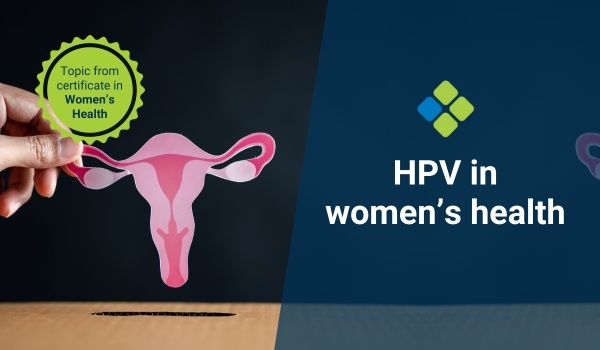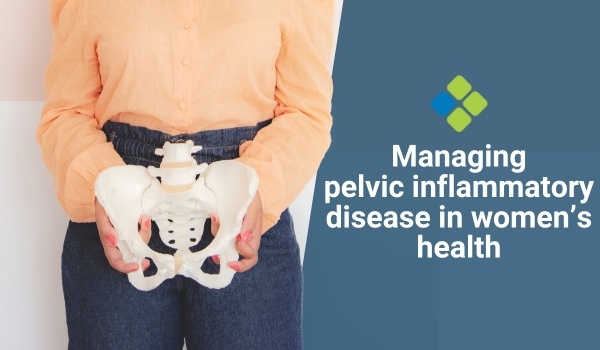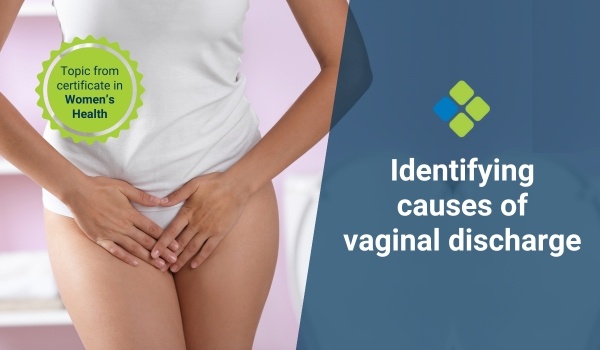HPV in women's health
Read about HPV in women's health, including testing, vaccines and risk reduction, and management of complications like cancer, infection and genital warts.

HealthCert Education
Human papillomavirus (HPV) is a group of over 200 viruses, most of which cause asymptomatic infection which spontaneously resolves without complications. High-risk types HPV-16 and HPV-18 are responsible for approximately 70% of cases of cervical cancer. Low-risk types such as HPV-6 and HPV-11 can cause genital warts. HPV is typically spread via sexual activity or skin-to-skin contact of infected areas. It is important for clinicians to reassure patients that HPV is very common, easily spread, and, in most cases, harmless.
Genital warts
HPV is typically asymptomatic. However, genital warts caused by low-risk HPV present as fleshy lumps around the anogenital area. Genital warts do not always require treatment and typically spontaneously resolve within six months.
Treatment is indicated where warts are uncomfortable, itchy, bleed or interfere with urinary or sexual function. Treatments include cryotherapy, topical podophyllotoxin or imiquimod, and surgical removal.
It is important to educate patients that the types of HPV that cause warts are not associated with the development of cancers.
Infection
Infection with high-risk types of HPV may cause cell dysplasia and cervical cancer, which can present with unusual or unscheduled vaginal bleeding. In women who present with such symptoms, it is important to take an accurate history, including a sexual history and cervical smear results.
Bimanual pelvic and speculum examinations are important to assess for signs of infection or HPV-related disease.
HPV testing
HPV testing is only performed in Australia via cervical screening, which checks for 12 oncogenic types of HPV, including HPV-16 and HPV-18, every five years. The general practitioner should encourage and empower women to attend routine cervical screening.
For women overdue a cervical smear and have declined speculum examination, self-collection may be possible. It is not possible for the primary care practitioner to test for HPV without the cervical screening program.
For women who have tested positive for HPV on a cervical smear, it is important to acknowledge and address concerns and ensure women are well-informed about the implications and follow-up.
All samples that are positive for HPV are evaluated using liquid-based cytology (LBC) to assess for cell changes. A repeat cervical smear is advised when LBC is negative or shows a possible low-grade squamous intraepithelial lesion. Where LBC shows a possible high-grade squamous intraepithelial lesion or worse, the patient is referred to colposcopy.
Vaccination
There is a safe and effective vaccination available against HPV, which has been included in Australia’s National Immunisation Program since 2007 and is recommended for all women and girls aged 9 to 25 and certain other women who may be at increased risk of developing HPV-related disease.
The current vaccination (Gardasil® 9) protects against nine types of HPV (6, 11, 16, 18, 31, 33, 45, 52 and 58). The HPV vaccine is most effective when given before exposure to HPV. Therefore, women should be encouraged to get vaccinated before becoming sexually active.
Unvaccinated women under the age of 26 should be offered and encouraged to have the HPV vaccine. For unvaccinated women aged 26-45, the vaccination is approved for use but not typically free. In this case, the benefits of the vaccination should be discussed to enable women to make an informed decision if they wish to be vaccinated.
Risk reduction
Finally, the primary care practitioner should educate women on how to reduce the risk of HPV and HPV-related disease. Since HPV is primarily spread through sexual contact, barrier protection (condoms) should be recommended.
Regular cervical screening and adherence to any follow-up are paramount to reducing the burden of HPV-related diseases.
Dr Samantha Miller, MBChB
Learn more about this topic in the HealthCert online Professional Diploma program in Women's Health
Read another article like this one: How to manage female patients considering a hysterectomy
Engaging with this blog can help meet your annual
|
|
|
1. Australian Family Physician (2005). Cervical screening and human papillomavirus. https://www.racgp.org.au/getattachment/25910cb6-c445-4728-916c-de3bb85d996f/200507sheary.pdf
2. Australian Government Department of Health and Aged Care (2023). Vaccination Handbook. Human papillomavirus (HPV). https://immunisationhandbook.health.gov.au/contents/vaccine-preventable-diseases/human-papillomavirus-hpv
3. Australian Journal of General Practice (2018). Human papillomavirus testing as part of the renewed National Cervical Screening Program. https://www1.racgp.org.au/ajgp/2018/july/national-cervical-screening-program
4. Cancer Council (2023). The HPV Vaccine. https://www.hpvvaccine.org.au/hpv-vaccine
5. NHS (2022). Human Papillomavirus (HPV). https://www.nhs.uk/conditions/human-papilloma-virus-hpv/
6. NHS Inform (2024). Cervical Cancer. https://www.nhsinform.scot/illnesses-and-conditions/cancer/cancer-types-in-adults/cervical-cancer/
7. National Centre for Immunisation Research and Surveillance (2022). Human papillomavirus (HPV) vaccines for Australians https://www.ncirs.org.au/sites/default/files/2022-07/HPV%20Factsheet_July%202022%20update_Final.pdf

 1800 867 1390
1800 867 1390







